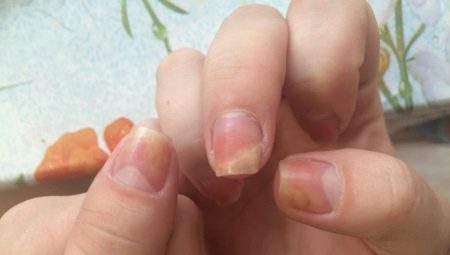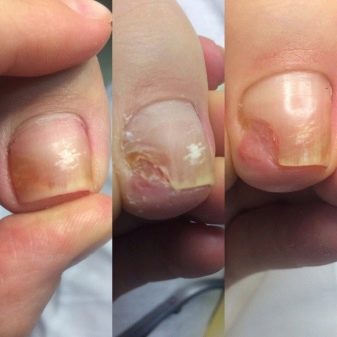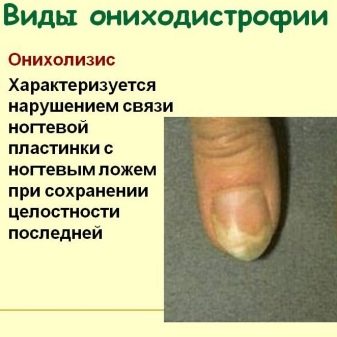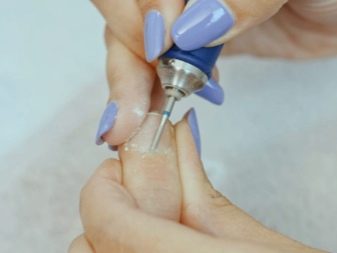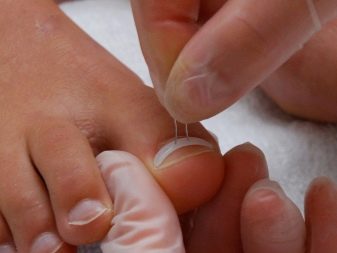In pursuit of beauty, women often acquire unpleasant diseases that are directly related to the methods used for beauty guidance. One of the most common problems in women who often grow nails or use gel polish is onycholysis.
About ailment
Onycholysis is called a lesion of the nail plate, associated with its distal detachment. Pathology can develop on a single finger, and can hit several nails at once on both hands and feet. In rare cases, all the nails exfoliate. In most cases, this is due to a traumatic impact on the plate (shock, bruise, pinching). Everyone knows that a pinched nail “disappears” over time. This is a traumatic onycholysis. In one third of cases, fungi are responsible for detachment of the nail plate. A large proportion of all cases occur in women who use fairly aggressive means for nail care.
Onycholysis is not contagious unless it is fungal. By and large, it does not interfere with living, and delivers only aesthetic visual inconveniences: the affected nail plates do not look the most attractive way.
The reasons
The cause of onycholysis can be not only the use of gel polish. Often the problem is indicated in case of injury, mycosis and allergies.
- If the nail plate was injured, the process is quite deep, hematoma under the nail squeezes blood vessels, nutrition of the nail deteriorates. There is a change in its color and structure, the plate is deformed. From the edge, which was more mobile, detachment occurs. The wider the area of detachment, the more likely the accession of a bacterial infection and associated inflammatory process. Fully nail plate rarely exfoliate.
- Infectious lesion of the nail plate It may well occur during the processing of nails for a manicure, and when infected with fungi. In this case, the blood supply of the plate is disrupted, its structure changes, often the plate leaves the bed completely. After treatment, a full growth of a normal new nail plate is possible.
- Allergic Onycholysis may develop as a reaction of the body to certain types of nail polish, for example, to gel polish, if a woman uses it often. If a woman does not give her nails a “rest”, then their water-salt and vitamin balance is not replenished. It is possible that a long stay of the nail plate under a layer of gel polish can lead to deformation and the beginning of any form of onycholysis.
- In addition, the development of pathology is not excluded. against the background of endocrine disorders, diseases of the gastrointestinal tract, as well as frequent UV irradiation of the nails.
How does it manifest itself?
To confuse onycholysis with something else is quite problematic: the symptoms of this pathology are too characteristic. The nail plate begins to separate from the free edge. The color of the nail changes from a healthy body to a grayish one, as some air gets into the stratified space. If pathogenic bacteria get into the space under the nail at this stage, the plate will turn yellowish, the fungi give it a brown color, and the blue pus bacillus will turn green. The plate becomes uneven, begins to deform. There may be an unpleasant smell from the nail.
Treatment
The treatment of pathology involved a dermatologist. This specialist can determine by a single appearance and the result of analysis on the microflora why this happened and suggest the optimal treatment regimen.The approach to treatment is always carried out comprehensively. First, the cause of onycholysis is eliminated. If these are diseases, then they should be treated. If it is a matter of frequent manicure, the nails should be allowed to rest and not to paint them for some time and not to be exposed to UV radiation.
A woman is shown taking multivitamins and topical use of vitamin aids on nail plates. Especially useful drugs are calcium, iron.
The detached part in case of partial damage should be regularly cut and treated with antiseptics. It is desirable to protect the injured nail plate with a bactericidal plaster. With a large area of detachment, surgical treatment will be applied, connected with the removal of the nail plate and cleaning of the bed. After that impose a sterile bandage.
Aniline dyes, alcoholic solutions, and antifungal agents can be used to treat bacterial and fungal lesions.
During the entire course of treatment, it is forbidden for a woman to contact the damaged nail plate with water, manicure products, varnishes and any household chemicals. If there is a need to wash the dishes, it should be done in special durable rubber gloves, while bathing in the shower or bath it is necessary to isolate the diseased nail with a bactericidal adhesive.
Reviews
According to the reviews of women left on the forums, the treatment of onycholysis itself does not cause major problems. But after it, it is not always possible to restore even plates, sometimes the deformations are preserved to some degree for years. Another danger that women are talking about lies in the likelihood of a relapse, when, after a completed course of treatment, the woman decides to turn to using gel polish again.
On why there is onycholysis in women and how to treat it, see below.
